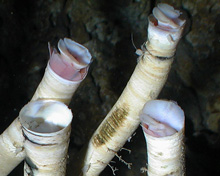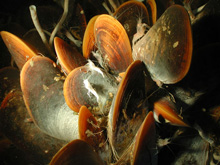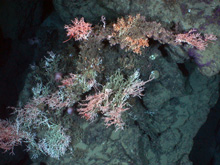An undescribed species of Lamellibrachia, some with their red plumes extended out of their tubes. Click image for larger view and image credit.
A close-up of the mussel Bathymodiolus brooksi, with one of the common species found in tubeworm and mussel habitats — the shrimp Alvinocaris muricola. Click image for larger view and image credit.
Conservation in the Deep Sea
Erik E. Cordes
Harvard University
One of the primary purposes of the Expedition to the Deep Slope 2007 is to determine where the high-biomass deep-water communities lie in the northern Gulf of Mexico. These communities are associated with ongoing or historic seepage of oil or gas at the sea floor, which is one indication of subsurface oil reserves. As exploration for new energy sources continues into deeper water, it is important to locate and set aside these sensitive areas so they are not disturbed. Locating these communities allows oil exploration to continue without having as great an impact on the amazing organisms about which we are just starting to learn.
The tubeworms of the Gulf of Mexico seeps are among the longest-lived animals on the planet. This statement is based on a number of studies we have performed on the tubeworm species on the upper continental slope over the last 10 years. On this cruise, we will be collecting selected tubeworms we stained last year so we can see if the related species of tubeworms in deeper waters get to be as old, or possibly even older. The tubeworms and mussels create habitat for a number of species that are found only at these seep sites, and many of the fishes and crustaceans found in the surrounding areas come to these sites to feed. So by protecting the tubeworms and mussels, we are also preserving the habitat for a whole community of animals.
A down-looking image of a colony of Madrepora oculata from Green Canyon 852. Click image for larger view and image credit.
At some of the sites, there are also colonies of deep-water corals. So far, we have found hard corals, bamboo corals, and other sea fans. Like the tubeworms and mussels at the active seeps, the corals species support a large associated community that we are just beginning to describe. Of the 10 sites we visited last year, only one contained extensive coral habitat, which gives us a hint of just how rare these sites may be in the deep Gulf of Mexico. We have selected a number of sites to explore this year with hopes that we will discover more coral habitats and fill in some of the gaps in our understanding of the chemosynthetic communities as well. Of course, the more new sites we visit, the greater the chance that we will discover something never before seen!


































